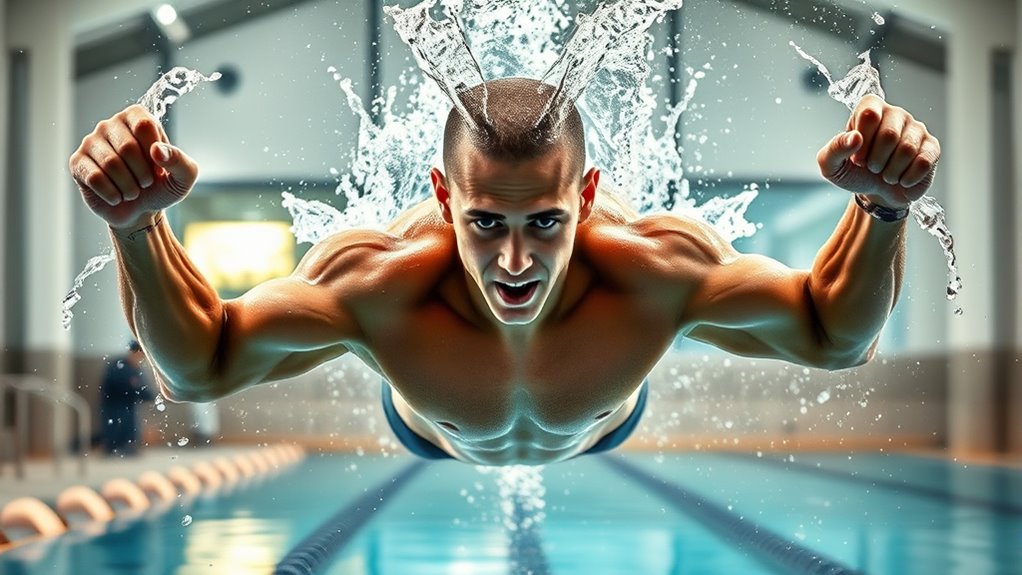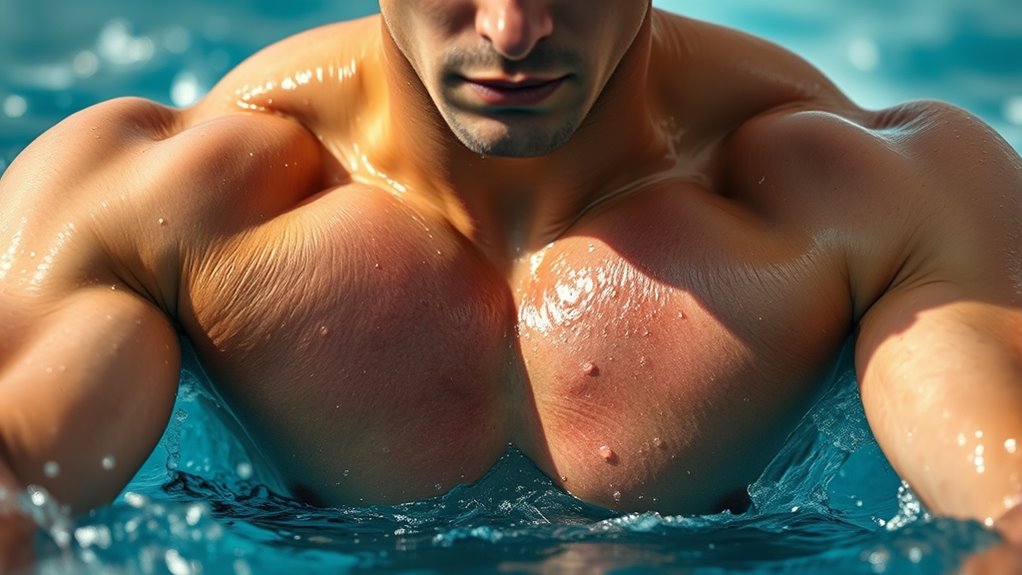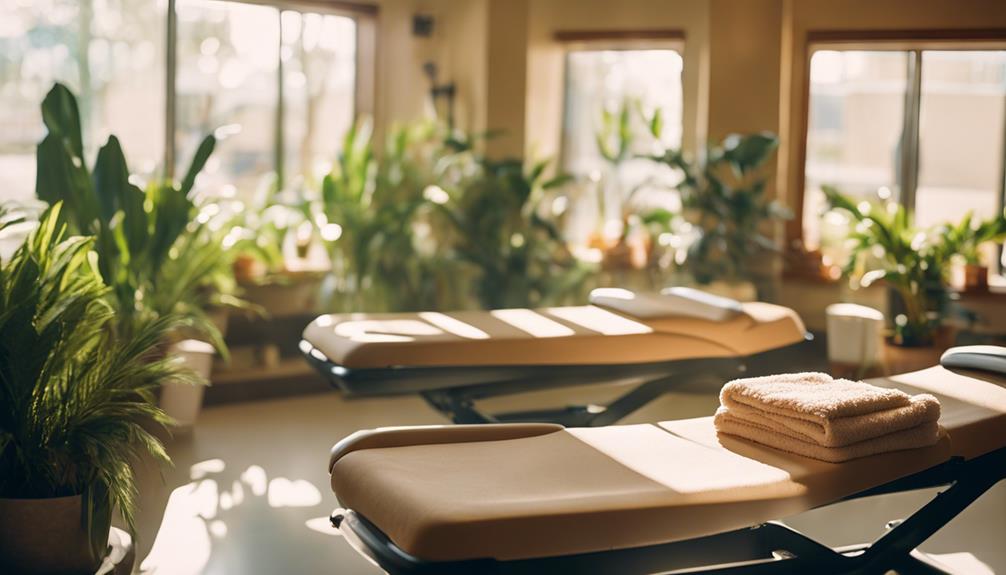To build upper body strength without weights, focus on bodyweight exercises like push-ups, incline and decline variations, dips, and pull-up progressions. Incorporate dynamic stretches and mobility routines to improve flexibility, which enhances stroke efficiency. Regularly practice core exercises like planks and mountain climbers to support your upper body and boost endurance. Staying consistent with these routines can markedly improve your swim power and technique—keep going to discover even more effective ways to enhance your performance.
Key Takeaways
- Utilize bodyweight exercises like push-ups, dips, and pull-up progressions to build upper body strength without weights.
- Incorporate variations such as incline, decline, or wide-arm push-ups to target different upper body muscles.
- Perform isometric holds like planks and side planks to enhance core stability supporting upper body performance.
- Include dynamic movements like mountain climbers and arm circles to improve upper body endurance and mobility.
- Regularly practice flexibility exercises to increase shoulder and thoracic mobility, boosting upper body strength and stroke efficiency.

Building upper body strength is essential for swimmers aiming to improve their performance, and you don’t need weights to achieve it. Developing this strength involves more than just arm movements; it requires focusing on your core endurance and incorporating flexibility exercises to maximize results. Your core acts as the foundation for powerful, efficient strokes, so strengthening it helps stabilize your body in the water and transfer force more effectively. By engaging your core regularly through targeted exercises, you’ll notice improvements in your overall swimming efficiency and endurance.
Flexibility exercises are equally important because they allow your muscles and joints to move through their full range of motion. Increased flexibility reduces the risk of injury and helps you execute strokes more smoothly. Incorporate dynamic stretches before workouts to prepare your muscles for activity, and static stretches afterward to improve your mobility over time. For example, shoulder stretches, chest openers, and thoracic spine rotations can considerably enhance your upper body flexibility, translating into more powerful pulls and better posture in the water.
To build upper body strength without weights, focus on bodyweight exercises that target key muscle groups. Push-ups are a fundamental move that strengthens your chest, shoulders, and triceps while also engaging your core. Variations like incline or decline push-ups can increase difficulty as you progress. Dips using parallel bars or even sturdy chairs target your triceps and shoulders, helping with pushing power during strokes. Incorporating pull-up progressions or assisted pulls can boost your back and biceps strength, essential for pulling through the water.
Complement these exercises with a disciplined routine of core endurance training. Planks, side planks, and mountain climbers are excellent for building stability, which directly benefits your swimming posture and reduces fatigue. You can also try leg raises or flutter kicks to strengthen your lower core, supporting your entire body during swimming. Remember to perform these exercises with proper form and gradually increase intensity to avoid overtraining.
Flexibility exercises should be integrated into your routine at least a few times a week. Yoga and dynamic stretching routines are particularly effective because they improve flexibility while also promoting relaxation and mental focus. Consistently working on your core endurance and flexibility will lead to more powerful strokes, greater stamina, and fewer injuries. You’ll find that with dedication to these non-weighted exercises, your upper body strength improves steadily, and your overall swimming performance reaches new heights. Additionally, understanding the importance of IRA tax implications can help you plan your overall financial strategy to support your swimming goals.
Frequently Asked Questions
Can Bodyweight Exercises Improve Swimming Endurance?
Yes, bodyweight exercises can improve your swimming endurance by enhancing core stability and cardiovascular endurance. When you incorporate moves like planks, push-ups, and burpees, you strengthen key muscles used in swimming, making your strokes more efficient. These exercises also boost your heart rate, building cardiovascular endurance. Consistently doing bodyweight workouts helps you swim longer and faster, improving overall performance without needing weights.
How Often Should Swimmers Train Their Upper Body Without Weights?
You should train your upper body with bodyweight routines about 3 to 4 times a week. This training frequency allows you to build strength without overtraining, giving your muscles time to recover and adapt. Focus on exercises like push-ups, planks, and dips to enhance your swimming performance. Consistency is key, so stick to your schedule and gradually increase the intensity for best results.
Are Resistance Bands Effective for Upper Body Strength?
Feeling like a modern-day Hercules, you’ll find resistance bands highly effective for upper body strength. They offer excellent resistance band benefits, helping you build muscle and improve endurance without bulky weights. Resistance bands provide versatile upper body resistance, targeting key muscles involved in swimming. Plus, they’re portable and easy to incorporate into your routine, making them a smart choice for enhancing your strength anytime, anywhere.
What Are the Best Stretches for Upper Body Flexibility?
To improve your upper body flexibility, focus on stretches that enhance shoulder mobility and chest openness. Try shoulder circles and arm crosses to loosen up your shoulders, and include chest stretches like doorway stretches or lying chest openers. These moves help increase flexibility, reduce tension, and improve movement efficiency, which benefits your swimming. Incorporate these stretches regularly to see progress in your shoulder mobility and overall upper body flexibility.
How Can I Prevent Shoulder Injuries During Workouts?
Think of your shoulders as a delicate bridge needing careful maintenance. To prevent injuries, focus on improving shoulder mobility through dynamic warm-ups and targeted stretches before each workout. Incorporate strength exercises that enhance stability, like rotator cuff movements, and avoid overexertion. Listening to your body, maintaining proper form, and gradually increasing intensity are key steps. These habits will help keep your shoulders resilient, safeguarding you from injury during every swim session.
Conclusion
You don’t need weights to build upper body strength for swimming. Bodyweight exercises like push-ups, planks, and dips are highly effective and accessible. Some might think they’re not enough, but consistency and proper form make a big difference. Keep challenging yourself and stay committed, and you’ll see improvements. Remember, you don’t need fancy equipment—your own body is a powerful tool for enhancing strength and boosting your swim performance.










